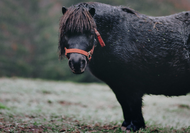Autumn has arrived and with it the increased risk of laminitis and Cushings related to the season change. The dry fields are starting to sprout with luscious lengths of green, green grass and other pastoral delights associated with the autumn flush.
It’s yum-yum time for horses, and there are some easy keepers that may be inclined to overdo it and gorge themselves to the point of obesity. A propensity to gain weight can be exacerbated by insufficient exercise. Out in the wild horses would be constantly on the move while foraging; in our rich pastures though they graze contentedly and probably still get topped up with commercial feeds and supplements as well.
Chubby horses are in danger of becoming insulin resistant and suffering from Equine Metabolic Syndrome and Cushings Disease. These disorders are more common in easy keepers and associated with endocrinological laminitis.
Insulin resistance shows in symptoms like abnormal weight gain or loss, increased water consumption, abdominal bloating, loss of stamina and a tendency to develop laminitis or colic. A vet can make a diagnosis using blood tests, and if the problem is still at an early stage preventive measures can be put in place.
MONITORING WEIGHT
It’s a good idea to keep a constant watch for weight gain, not only visually but also by using aids like a simple WeighTape. With a few measurements you can use a formula to calculate his weight (instructions come with the tape).
To guess-timate how his weight is doing, you should be able to feel his ribs easily when you run your hand along his side, but not be able to see them. There shouldn’t be any visible fat deposits along the crest, loins, tailhead or around the udder or sheath. Such deposits are one of the first signs that your horse or pony is developing insulin resistance.
One of the main preventive measures for Insulin Resistance is limiting the horse’s consumption of sugars and starches, both in commercial feed and pasture. In other words, your horse has to be put on a calorie-controlled diet, probably in conjunction with a feed balancer.
Your easy keeper becomes hard work when you have to manage his weight.
RESTRICTING GRASS INTAKE
During the spring, summer and autumn it is very difficult to prevent a horse from grazing, unless you keep him stalled or on dirt turnout for a great deal of the time. This is neither very practical or desirable for either you or the horse. A good alternative is to use a grazing muzzle which won’t stop him from enjoying the pasture, but will restrict his grass intake.

Grazing muzzles are controversial in horse circles; many are concerned that they are cruel and unnecessary while others regard them as a lifesaver for obese ponies and horses. Like all horse management tactics and techniques, however, it’s a case of if the solution works, use it. Not all horses will take to the muzzle – and in fact none of them will enjoy it immediately. The trick is to use it as a “last resort” sensibly, appropriately and humanely, for the welfare of the animal.
CORRECT USE OF A GRAZING MUZZLE
Grazing muzzles come in a variety of shapes and sizes, but ultimately they are all designed not to prevent the horse or pony from eating, but to limit the amount of grazing he is able to ingest.
NOTE: It’s important to stress that a grazing muzzle should only be used in combination with veterinary advice about the overall nutrition and lifestyle of your overweight horse or pony. And they shouldn’t be used at all for donkeys.
If you decide to use a grazing muzzle the most important first step is to get the fit spot on. The device must be comfortable and not rub.
The National Equine Welfare Council (NEWC) advises that you should be able to fit two fingers underneath the noseband of the grazing muzzle. Also, there should be a gap of an inch between the horse’s mouth and the base of the muzzle to ensure the horse’s mouth is not in constant contact with the base of the muzzle. The horse or pony should be able to open his mouth comfortably. Make sure he is able to drink easily while wearing the muzzle.
Your horse should be constantly monitored while wearing his muzzle. The length of time he wears it for should be regularly reviewed, but it should never be longer than around 10 hours a day. When he’s not wearing it restrict his grazing in other ways.
INTRODUCING A GRAZING MUZZLE
As with any new piece of equipment it will take time and patience to get your horse or pony used to a grazing muzzle. He can’t understand that you are doing this for his own good!
Begin by teaching him to accept having the muzzle near his face by holding it against his head for a few seconds. When he accepts this calmly place it over his nose, again for a few seconds, rewarding him with a low-calorie treat or a scratch in his favourite spot if he stays calm and happy. You will have to repeat this exercise numerous times, increasing the length of time you hold the muzzle over his nose. Eventually you can gently attach the muzzle for a few seconds, remove it and reward him.
When he seems comfortable in the muzzle lead him out to graze, and supervise him while encouraging him to eat.
Whether he accepts the muzzle happily will depend largely on his temperament, and your calm, relaxed attitude. Don’t rush him.
You should never just put it on and leave him unattended for the first few times he wears it. Build up the experience from a few minutes at a time, offering constant re-assurance, and if he shows distress keep calm, and start again.
ACADEMIC RESEARCH INDICATES THAT USING A GRAZING MUZZLE CAN REDUCE THE AMOUNT OF GRASS CONSUMED BY AS MUCH AS 83%.
We’d love to hear your experiences of using a grazing muzzle. Post your comments on our Facebook page or Tweet us!



